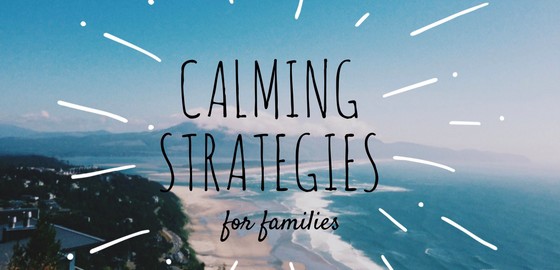This morning, I taught my Emotions & Me Workshop focused on Anxiety. I loved it. One of my favorite things is working with children and parents together because I recognize the power of that parent-child relationship in creating change. One of the topics discussed focused on calming strategies that families can use to help children (and adults) manage anxiety.
During the workshop, I utilized a handout that described calming strategies and calming statements that children and families can use to manage anxiety. I believe that children cannot learn how to do these interventions alone, they need support and guidance from a trusted adult as they learn to use these strategies and build their confidence. I decided to modify the handout that I used and share some of the information with all of you, too!
You may also be interested in reading my previous post, Children & Stressors: The Anxious Child.
Calming Strategies for Families
• Deep breathing. Check out this previous post for more information about how to help children learn to master deep breathing.
• Hug a stuffed animal or blanket
• Color
• Listen to music
• Talk to a supportive person
• Use a worry box. A child or family creates a worry box where they can store drawings or notes that they have created to express/process their worries.
• Practice mindfulness-staying in the moment
• Physical activity: Going for a walk, yoga
• Imagine a safe place
• Stress ball or fidget
• Sensory play-sand, beans, play dough
Calming Statements for Families
Additionally, the use of calming statements may be effective for families. It can be very difficult for adults to figure out how to support a child through their anxiety because we are not always certain of the “right” thing to say. We try to find that balance of acknowledging the child’s feeling, but also supporting them in being able to work through their anxiety. The calming statements shared below are worded so that initially caregivers can use these statements to help calm their child. The ultimate goal is that eventually a child may be able to tell themselves these types of statements to help calm themselves.
Examples of calming statements:
• You are feeling worry/anxiety. OR I wonder if you are feeling worry/anxiety.
• Worry is normal and will pass. How can I support you until it does?
• You have learned how to calm your worry.
• You can use the tools you have learned to help you with your worry. I am here to help you use the tools you’ve learned.
• You can do this.
• You’ve done this before and you can do it again.
• You can ask me or another adult for help if you need it.
• I am proud of you.
• I am here for you.
• You are loved for who you are.
I hope the tips in this post have helped inspire you to think about how your family can use calming strategies to support family members who are struggling with anxiety.
Sarah
